Rock River Valley Chapter of the Studebaker Drivers Club
Our Charter, Keeping the Studebaker Marque Alive
|
 |
|
|
 |
|
|
|
|
Prelude: The Sedans and Wagons manufactured from 1956 to 1958 (the end of full sized cars) is a period of significant struggle for Studebaker. The reason these sought after cars are now becoming fairly scare is that there were just not that many of them made. Some were extremely low production, especially some of the Wagons and of coarse the 1958 Sedan Hardtops. Even the 1958 pod (dual headlight) cars, are being forgiven. Actually, these were very good cars with fair economy, nice styling, and a great ride. If your in the market for a Studebaker, you owe it to yourself take a look. PS Just my opinion.
The
1956 Champion:
 After
the 1953 to 1955 design cycle, in 1956, Studebaker was ready to
reshape the sedan and wagon body panels front and back. While the
center section would remain the same, gone were the sloping hood and
trunk. The new face lift would introduced squared-up styling for
1956. Many of the Studebaker executives felt that Studebaker had
developed a reputation for creating odd looking cars and wanted to
break that cycle for 1956. Lowey's expensive contract was not
renewed for the sedan and wagon design. Most of the exterior design
work is done by Vince Gardner (now a freelance designer) and most of
the interior is done by Duncan McRae. The grille, fenders,
taillights and sedan rear bumper were new. The sedan rear bumper, After
the 1953 to 1955 design cycle, in 1956, Studebaker was ready to
reshape the sedan and wagon body panels front and back. While the
center section would remain the same, gone were the sloping hood and
trunk. The new face lift would introduced squared-up styling for
1956. Many of the Studebaker executives felt that Studebaker had
developed a reputation for creating odd looking cars and wanted to
break that cycle for 1956. Lowey's expensive contract was not
renewed for the sedan and wagon design. Most of the exterior design
work is done by Vince Gardner (now a freelance designer) and most of
the interior is done by Duncan McRae. The grille, fenders,
taillights and sedan rear bumper were new. The sedan rear bumper,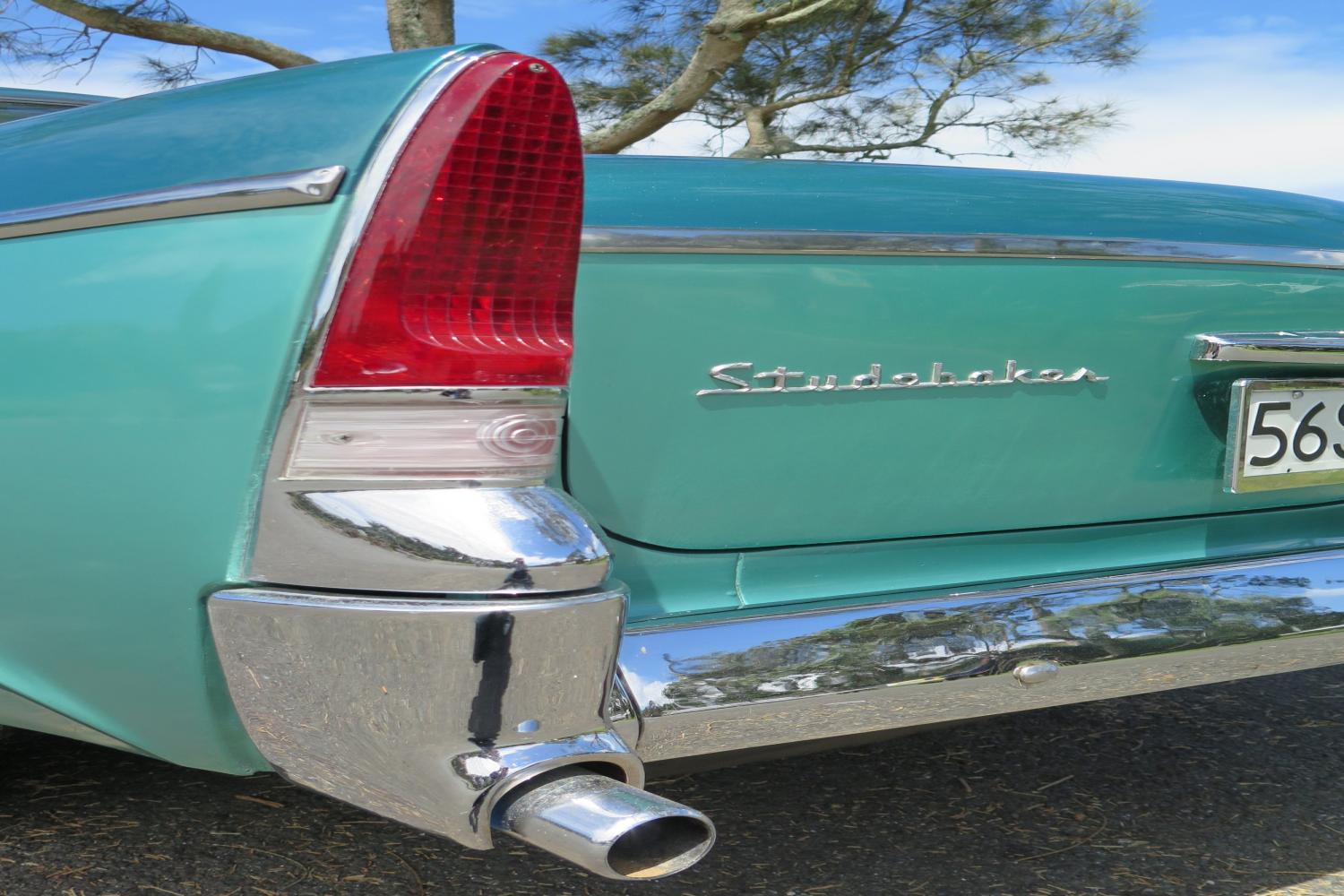 has slots for the exhaust pipes, which was all the rage in the
mid-fifties. However, after the chrome pitted and turned black, not
so much. The side “reverse angle contour” (still present on
Hawks), seen since 1953 is eliminated. The rear quarter panel on the
new two-door sedans extends all the way to the door, finally removing
that fake looking rear ½ door look. The wagon, still has the
sloping rear quarter panel, but a small fin is added to remove the
slope. The new grille has a large center section of square mesh,
with two side grilles. The coat of arms badge returns to the center
of the hood and there is a new bull's eye hood ornament. The 1947 to
1949 regular hubcaps return, the full wheel covers are new. Eyebrows top the headlights and a single side trim starts near the
headlight and ends at the taillight. It droops starting at the front
of the front door, running just below the door handles and then kicks
up rapidly and finishes in a straight line to the end. Exception on
this trim, is the Sedanet, where the side trim ends just before the
rear
has slots for the exhaust pipes, which was all the rage in the
mid-fifties. However, after the chrome pitted and turned black, not
so much. The side “reverse angle contour” (still present on
Hawks), seen since 1953 is eliminated. The rear quarter panel on the
new two-door sedans extends all the way to the door, finally removing
that fake looking rear ½ door look. The wagon, still has the
sloping rear quarter panel, but a small fin is added to remove the
slope. The new grille has a large center section of square mesh,
with two side grilles. The coat of arms badge returns to the center
of the hood and there is a new bull's eye hood ornament. The 1947 to
1949 regular hubcaps return, the full wheel covers are new. Eyebrows top the headlights and a single side trim starts near the
headlight and ends at the taillight. It droops starting at the front
of the front door, running just below the door handles and then kicks
up rapidly and finishes in a straight line to the end. Exception on
this trim, is the Sedanet, where the side trim ends just before the
rear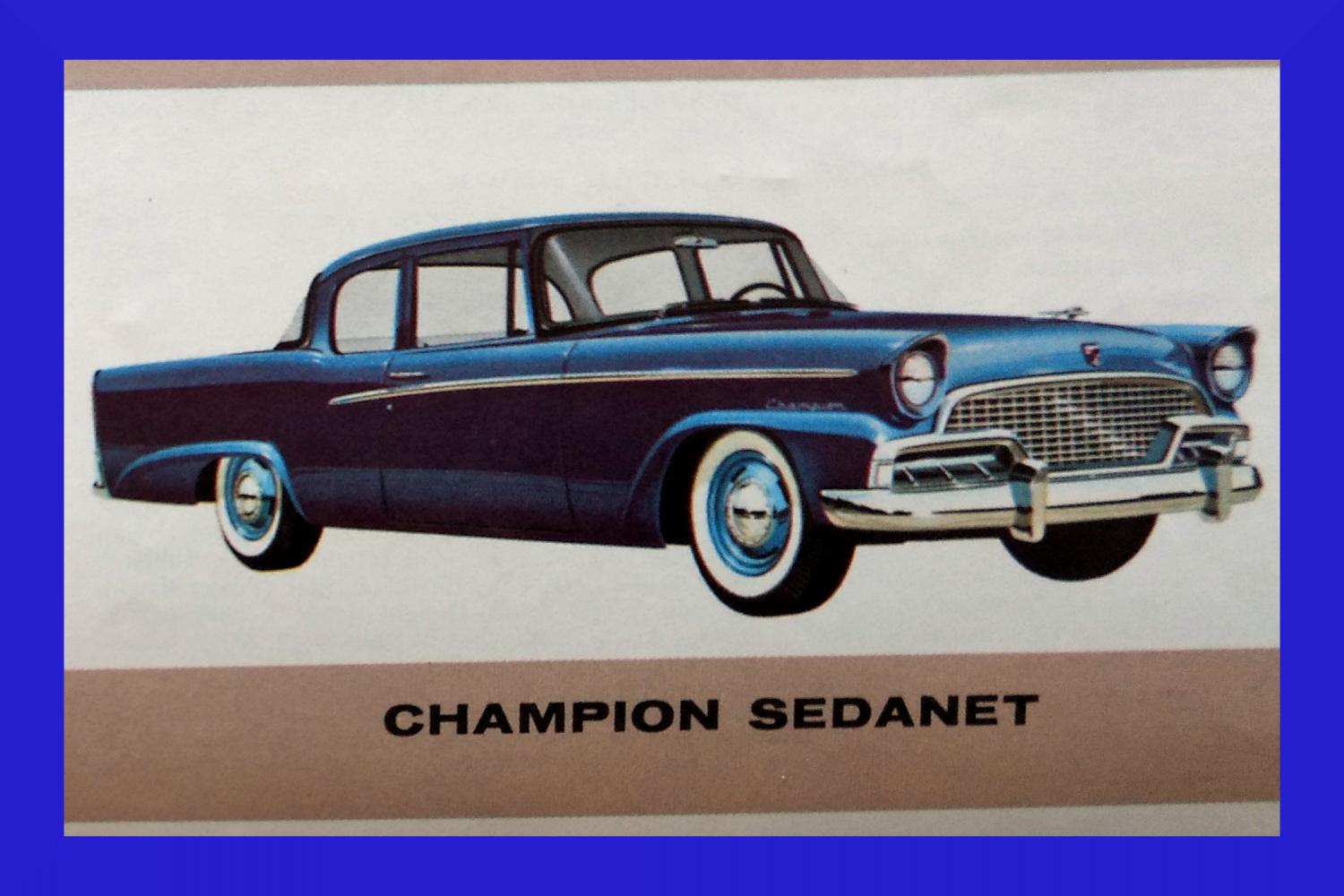 wheel well. Both the front fenders and the rear-quarter panels
have stamped-in flares just behind the wheel wells. wheel well. Both the front fenders and the rear-quarter panels
have stamped-in flares just behind the wheel wells.
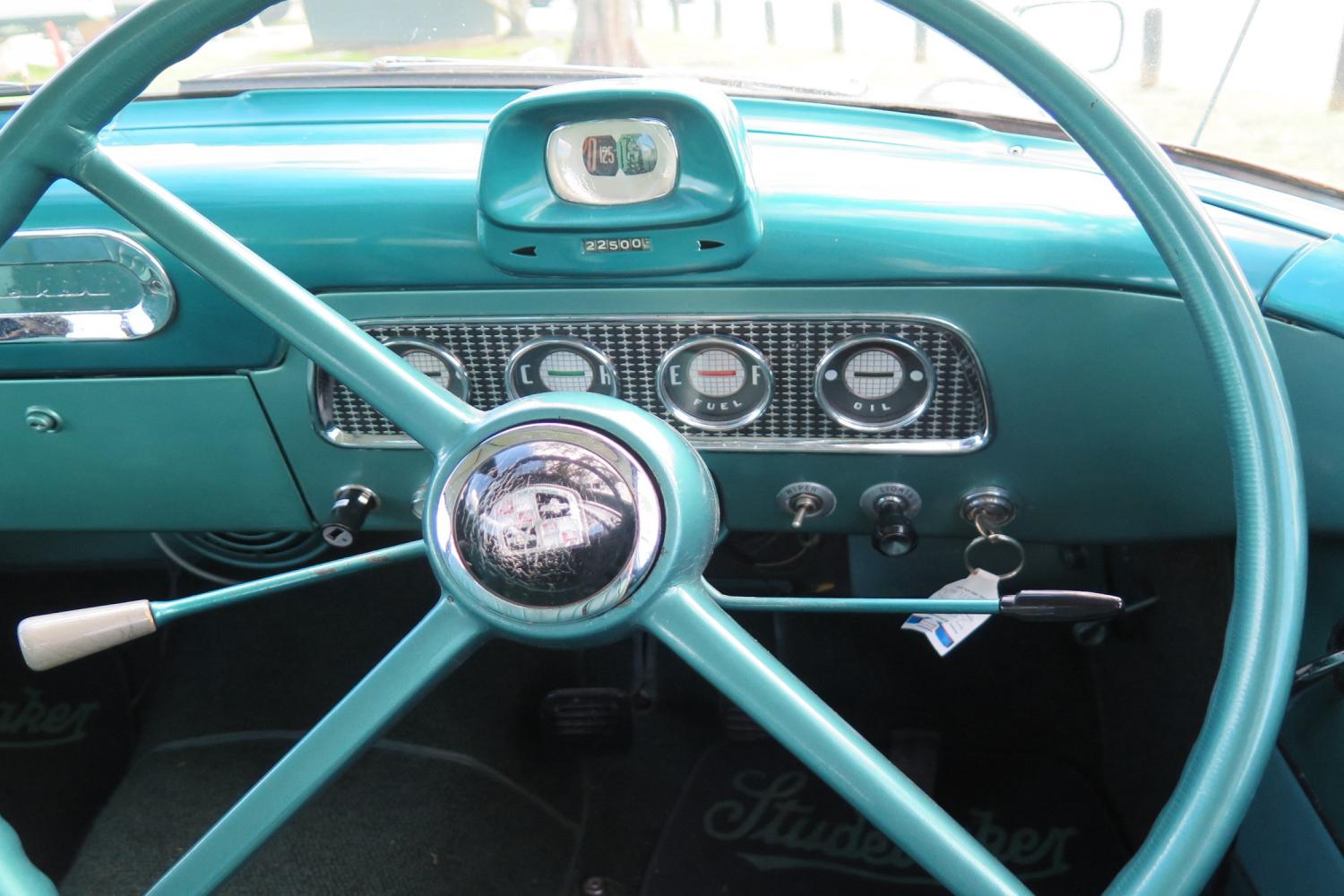 The
interior has a new dash design featuring a “Cyclops Eye”
speedometer on top of the four remaining instruments below; two
“idiot lights” for amps and oil pressure; and two red and green
lighted gauges for gas and temperature. The light and heater
controls were placed below these four gauges. The glove box is in
the center of the dash, below the radio (if installed else below the
radio delete panel). The clock and radio speaker (if installed) are
to the far right. Built in arm rests and colorful new cloth/vinyl or
all-vinyl upholstery are available. The door handles and window
cranks are now installed with hidden snap rings instead of those
former visible Phillips screw. The
interior has a new dash design featuring a “Cyclops Eye”
speedometer on top of the four remaining instruments below; two
“idiot lights” for amps and oil pressure; and two red and green
lighted gauges for gas and temperature. The light and heater
controls were placed below these four gauges. The glove box is in
the center of the dash, below the radio (if installed else below the
radio delete panel). The clock and radio speaker (if installed) are
to the far right. Built in arm rests and colorful new cloth/vinyl or
all-vinyl upholstery are available. The door handles and window
cranks are now installed with hidden snap rings instead of those
former visible Phillips screw.
Note: this is a right hand drive cars
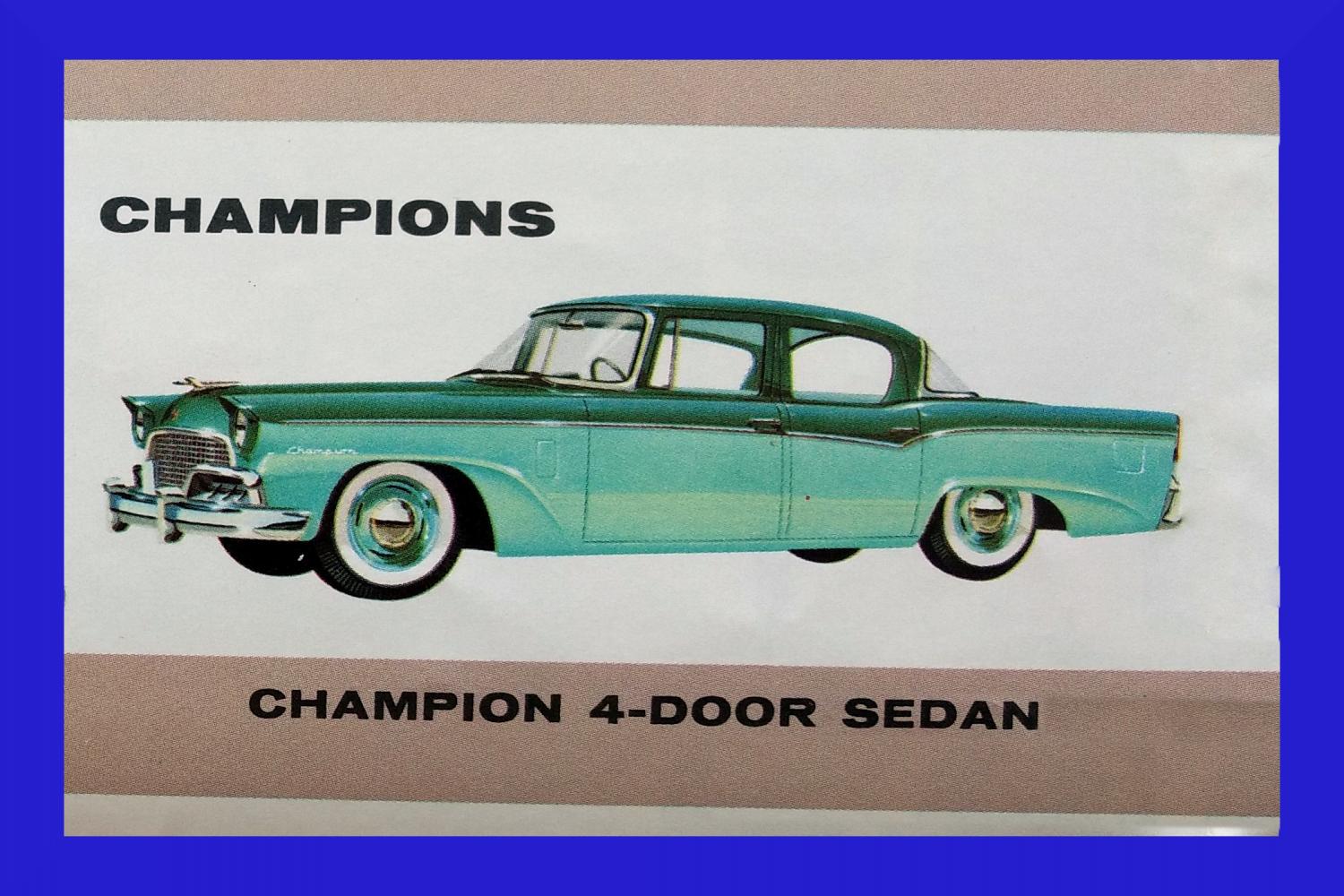 Mechanical
changes were limited, but significant. First, the electrical
system is now 12 volts. This would be the year most American car
manufactures changed over from 6 volts to 12 volts. 12 volt systems provided more starting power and could support a heavier electrical
load for things like power windows, power seats, and air
conditioning. Second, gone forever is the Automatic Drive
transmission. Having never lived up the volume Borg Warner or for
that matter Studebaker it's self had expected, this transmission just
becomes to expensive. The replacement is the Flightomatic, a two
speed automatic similar to a transmission Borg Warner would make for
Ford called the Fordomatic. Studebaker would use the PNDLR shift
pattern where Ford used PRNDL. The Flightomatic has no torque
converter bypass, but is a lot cheaper to produce. This would be the
staple automatic for Studebaker until the end of production. Mechanical
changes were limited, but significant. First, the electrical
system is now 12 volts. This would be the year most American car
manufactures changed over from 6 volts to 12 volts. 12 volt systems provided more starting power and could support a heavier electrical
load for things like power windows, power seats, and air
conditioning. Second, gone forever is the Automatic Drive
transmission. Having never lived up the volume Borg Warner or for
that matter Studebaker it's self had expected, this transmission just
becomes to expensive. The replacement is the Flightomatic, a two
speed automatic similar to a transmission Borg Warner would make for
Ford called the Fordomatic. Studebaker would use the PNDLR shift
pattern where Ford used PRNDL. The Flightomatic has no torque
converter bypass, but is a lot cheaper to produce. This would be the
staple automatic for Studebaker until the end of production.
Restoration
Information: Champion and
Commanders road on the same wheel base, 116.5 inches and the sheet
metal was the same for both cars. The difference, mainly in the
engine where Commanders were V8's and Champion's were straight-six. The model line-up was identical one Hawk (Flight Hawk / Power Hawk),
one Wagon (Pelham / Parkview), one 4-door Sedan, one 2-door Sedan,
and one 2-door Sedanet. The former trim levels like “Custom”,
“DeLuxe”, “Regal” are eliminated. The Sedanet is the least
expensive car, but is not near as spartan as the former “Custom”
series. They were initially painted only in single tone colors. Studebaker like most manufactures though the public was not
interested in a stripped down very spartan car. The Scotsman's for
1957 would prove how much they were wrong. At start of production 23
two-tone paint combinations were available and 10 solid colors. In
the spring, 6 new two-tone combinations would be offered and Sedanet
could be had with most of the color combinations. Five metallic
colors were used and two of the two-tone color combinations were
available only on the President Classic, (Mocha/Doeskin and Mocha/Snowcap
White). While of coarse , many options and accessories were
available, the newest would be the uniquely mounted “Karbelt”
(seat belt), which was attached to the door, not the floor. When not
in use, the longer section clipped to the door for storage. It was
though that this set-up would prevent the door from flying open in
the event of an accident. Click here to see the Options and Accessory listing.
Source: Parts of the information above is from "Studebaker the Complete Story" and "TW October 1989".
|
|
|
| Interior Seat Fabrics 1956 Sedans and Wagons (Domestic Models) |
|
Champion & Commander Sedanet |
|
Standard Upholstery |
Optional extra cost Upholstery |
|
Charcoal Diamond Pattern cloth with Offwhite vinyl bolster
|
All black Vinylab Waffle Grain Imitation Leather with Offwhite vinyl bolster |
|
Champion & Commander 2dr & 4dr Sedans
|
|
Standard Upholstery - Triangle Pattern Cloth with vinyl bolsters in the following colors:
|
| Cloth Seat Upholstery
|
Vinyl Bolster
|
|
Charcoal Black |
Offwhite |
|
Dark Blue
|
Light Blue |
|
Dark Green
|
Light Green |
|
Optional extra cost Upholstery - All vinyl in the following colors: |
|
Vinyl Seat Upholstery
|
Vinyl Bolster |
|
Charcoal Black |
Offwhite |
|
Dark Blue |
Light Blue |
|
Dark Green |
Light Green |
|
Champion Pelham and Commander Parkview Wagons |
|
Standard Upholstery |
Opional extra cost Upholstery |
Charcoal Black Vinyllap with Offwhite vinyl bolster |
Charcoal Nylon Frieze Cloth and Offwhite vinyl bolster |
|
|
|
Exterior Colors 1956 Sedans & Wagons |
|
Solid Colors |
|
|
Midnight Black |
P5611 |
|
Snowcap White
|
|
| Daybreak Blue
|
|
|
Airforce Blue Mettalic
|
|
|
Seaside Green
|
|
|
Glenbrook Green Metallic |
|
|
Cambridge Grey Metallic
|
|
|
Yellowstone
|
|
|
Two-Tones |
|
Accent Color
|
Basic Color |
|
|
|
Airforce Blue Matallic |
P5620 |
| Airforce Blue |
Daybreak Blue |
P5621 |
|
Snowcap White |
Daybreak Blue |
|
|
Snowcap White |
Daybreak Blue |
|
|
Seaside Green
|
Glenbrook Green Metallic |
|
|
|
Seaside Green |
|
|
Snowcap White |
Seaside Green |
|
|
Snowcap White |
Glenbrook Green Metallic |
|
|
Snowcap White |
Cambridge Grey Metallic |
|
|
Snowcap White |
Midnight Black |
|
|
Midnight Black |
Snowcap White |
P5630
|
| Midnight Black |
Romany Red |
P5631
|
|
Romany Red |
Midnight Black |
P5632
|
|
Romany Red |
Snowcap White |
P5633
|
|
Snowcap White |
Romany Red |
|
|
Sunglow Gold |
Romany Red |
|
|
Snowcap White |
Sunglow Gold |
|
|
Doeskin |
Mocha |
|
|
Snowcap White |
Mocha |
|
|
Midnight Black |
Yellowstone |
|
|
Sunglow Gold |
Yellowstone |
|
|
Snowcap White |
Tangerine |
|
|
Snowcap White |
Rosebud |
|
|
Snowcap White |
Redwood Metallic |
|
|
Redwood Metallic |
Snowcap White |
|
|
Seaside Green |
Midnight Black |
P5667 3 |
|
Daybreak Blue |
Cambridge Grey Metallic |
P5668 3 |
|
Snowcap White |
Yellowstoneit |
P5669 3 |
Champion and Commander Sedanets were only available in solid colors until April of 1956. After that date they could be ordered with most of the above two-tones (see 2). Colors 5619 & 5641 (not listed above) were used on some 1956 Hawks exclusively. Wheels were painted body color on solid tone cars or the basic color on two-tones.
1 Only available on the President Classic. 2 Discontinued in April 1956. 3 Spring color combinations introduced in April 1956. |
|
|
1956
Studebaker Champion Series 56G |
|
Model |
No.
Doors |
Passengers |
|
Original
Price |
No.
Produced |
|
Flight
Hawk(C3) |
2 |
5 |
$1,996.00 |
$1809.00 |
4,389 |
|
Pelham
(D4) |
2 |
6 |
$2,232.00 |
$2038.00 |
2,236 2 & 3 |
|
Sedan
(F4) |
2 |
6 |
$1,946.00 |
$1772.00 |
4,301 |
|
Sedan
(W4) |
4 |
6 |
$1,996.00 |
$1819.00 |
11,983 |
|
Sedanet
(F2) |
2 |
6 |
$1,844.00 |
$1678.00 |
3,097 |
|
4dr CustomSedan (W4) 1 |
4 |
6 |
? |
? |
1,170 |
|
4dr Regal Sedan (W6) 1 |
4 |
6 |
? |
? |
1,180 |
|
Total |
28,356 |
|
1 Special Order, Canada, and export. 2 All Canadian sold wagons were assembled in the U.S. 3 Includes D8 Ambulet production.
The data in this table is taken from CCD, except the TW Price, column 4. The CCD production numbers and TW production numbers were identical.
Serial numbers for South Bend –
G-1,357,501 to G-1,379,200 for Los Angeles – G-936,701 to G-938,797 for Canada –
G-763,701 to G-769,100
Starting engine numbers South
Bend – 1,180,251 to 1,202,100 for LA – L-3,201 to L-5,297 for Canada C-66,001 to C-71,400 |
The
1957 Champion: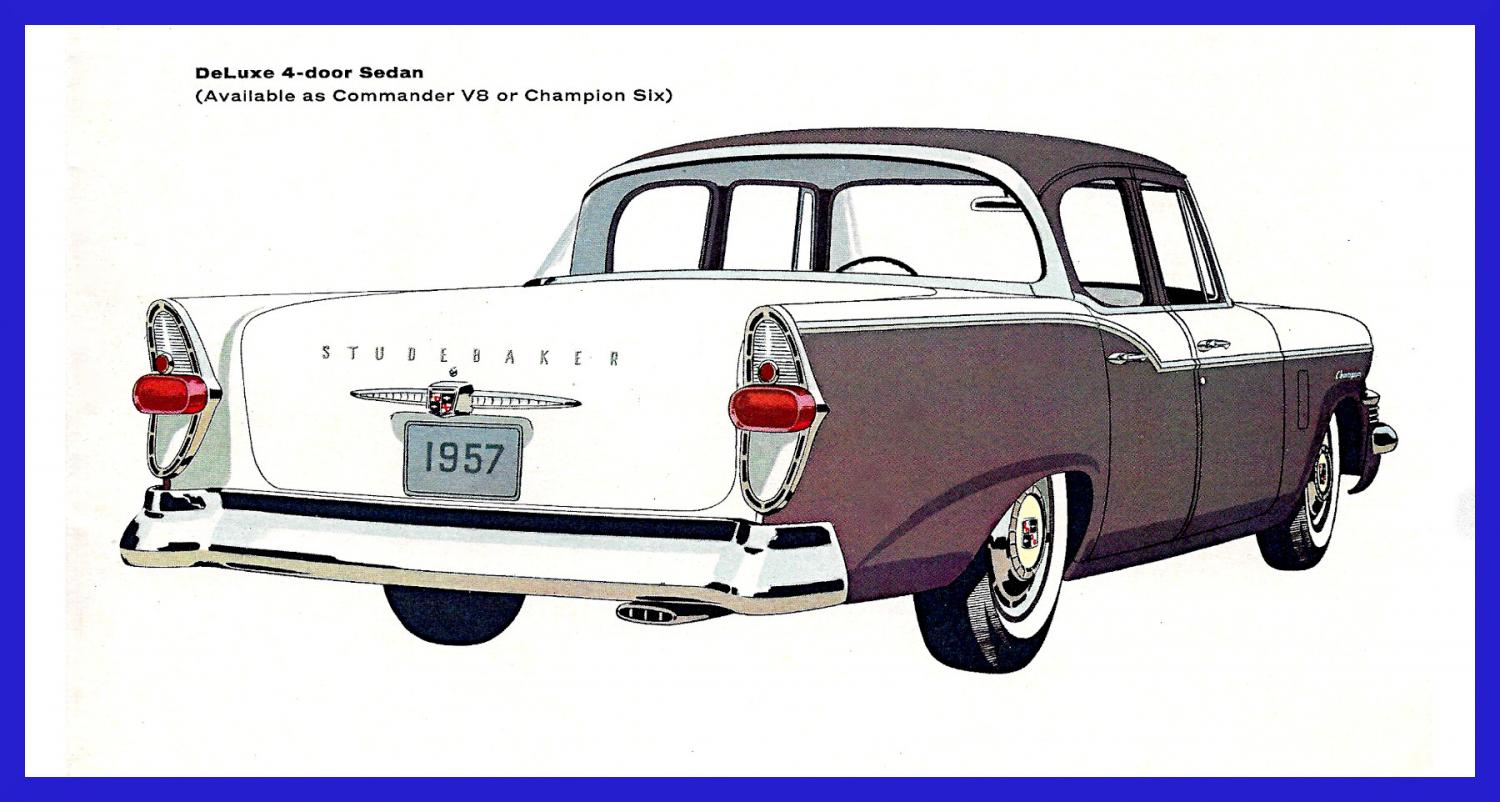
The 1957
Sedans and Wagons were mostly based on the 1956 models, the 1957
exterior changes included new front and rear bumpers, a new grille
design, and new taillights. The side trim and the full rim hubcaps
were revised. On the interior, the speedometer housing is widened to
include turn signal indicators. 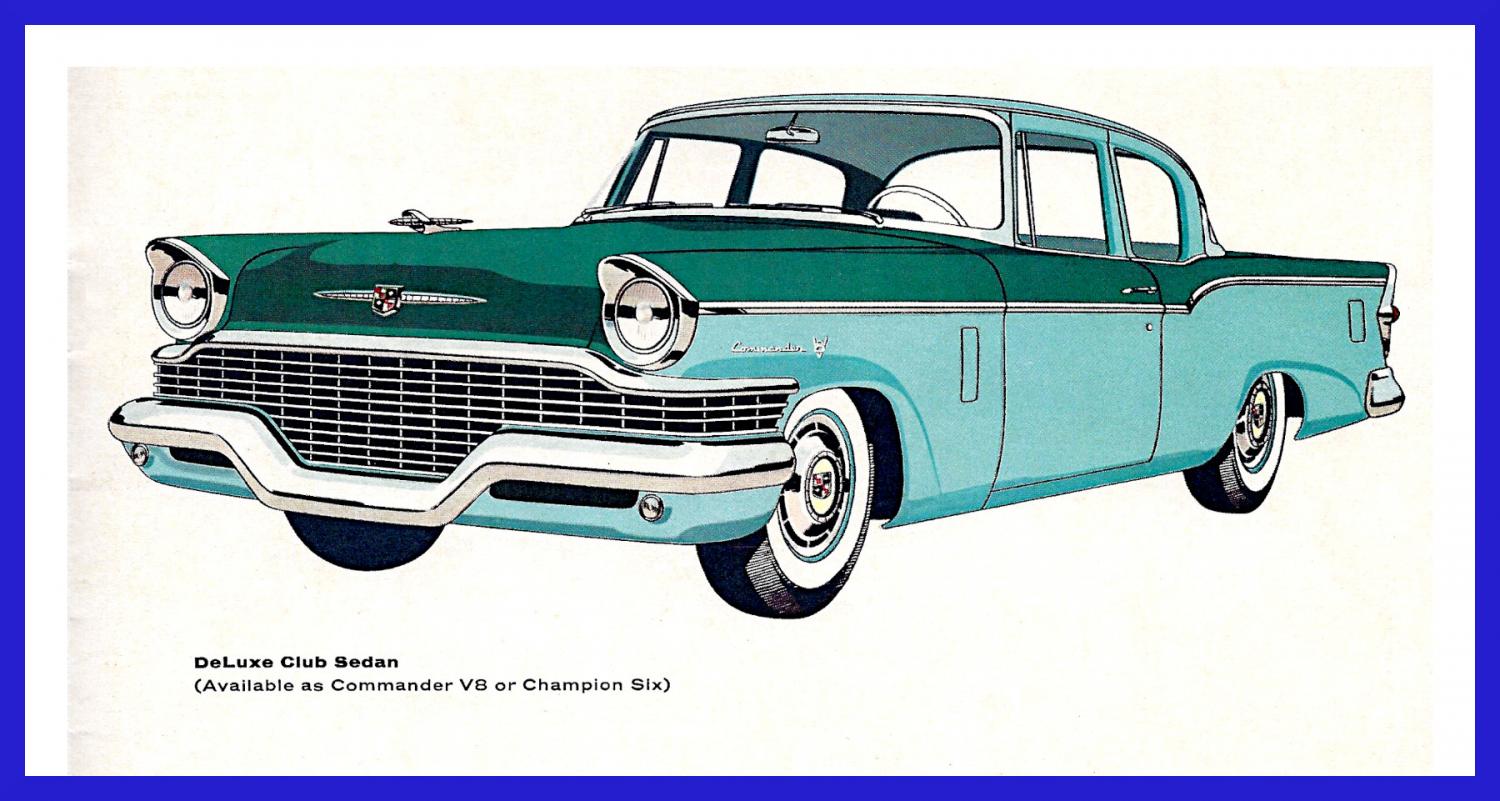 The molded -in arm rests from 56 are
replaced with a conventional replaceable versions and a new dished
steering wheel is standard on all but a few of the earlier Custom
models.
Mechanical improvements include new variable ratio front
coil springs and optional Twin-Traction introduced on 1956 Packard's
and light duty Studebaker trucks.
Last for
1957 is the release in May of the Scotsman line listed below. The
Scotsman is essentially a Champion stripped of 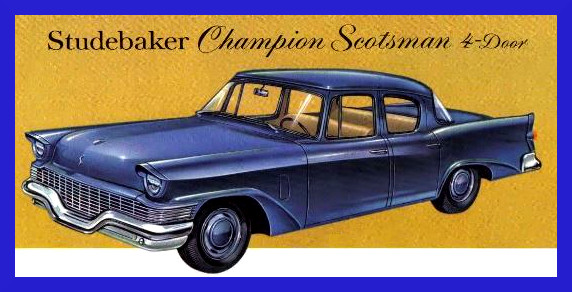 it's side chrome and other ornamentation. The interior is very basic. The speedometer
and trunk handle are left over 1956 parts and simple oil pressure and
charging warning lights are employed. The rear window are fixed. Exterior paint is limited to a choice of three solid colors. Vacuum
windshield wipers were standard with electrics as an option. Hill
Holder, TwinTraction, and wet type air cleaner were about the only
other options available. Dealers were discouraged from adding
options to this very spartan offering. The Scotsman is only manufactured
in South Bend and those sold in Canada were shipped there from South
Bend. There is no Los Angeles production as LA is shutdown at the
end of the 1956 model-year.
Restoration
Information: The earlier engines were painted Turquoise with
Black valve covers, air cleaner, generator, and starter. Most oil
pans, filler caps and fans were also Black. Fuel pump, wiper motor,
and carburetor were natural metal. Engines after about May of 1957
and all Scotsman engines were painted Silver-grey. The
panel under the front bumper on all Scotsman's and most later model
Sedans and Wagons was painted Silver-grey.
| Exterior Colors: 1957 Sedans & Wagons Solid Colors |
|
|
|
Color |
Code |
Studebaker |
Packard |
|
Midnight Black |
P5710 |
x |
x |
|
Artic White
|
|
|
|
| Apache Red
|
|
x |
|
|
Coppertone Metallic
|
|
|
|
|
Tiara Gold Metallic
|
|
|
|
|
Woodsmoke Grey Metallic |
|
|
|
|
Glendale Green Metallic
|
|
|
|
|
Turquoise
|
|
|
|
|
Azure Blue Metallic |
|
|
|
|
Wedgewood Blue
|
|
|
|
|
|
P5720 |
|
|
| Regal Red |
P5771 |
|
x |
|
Cumberland Grey |
|
|
x |
|
Lilac |
|
|
x |
|
Slate Mist Metallic
|
|
x |
x |
|
|
|
x |
x |
|
Admiral Blue |
|
x |
|
|
Highland Grey |
|
x |
|
|
Lombard Green |
|
x |
|
| *Spring Color **Scotsman Only. The Lombard Green color offered on 1957 Scotsmans was a returned 1953 color. The lower instrument panel color on Scotsmans was Florida Beige. |
Upholstery Materials: 1957 Sedans & Wagons |
|
A detailed presentation of all the interior fabrics and the exterior colors that they went with is beyond our scope here. That information can be found in Studebaker's 1957 Color and Fabric Selector dealer album. The following is just a listing of the fabrics and trim codes. The trim codes show up on the production orders. Production Orders for most years and models can be purchased from the Studebaker National Museum. Most fabrics are two-tone, light and dark. |
|
Scotsman |
|
Textured Breathable Naugahyde, & Grained Vinyl |
|
Color |
Code |
|
Charcoal (& tan) |
? |
Custom Champions & Commanders |
|
Triangle Pattern Cloth & Hair Cell Grained Vinyl |
|
Color |
Code |
|
Charcoal (& off white) |
21 CH |
|
Blue (two-tone) |
22 BL |
|
Green (two-tone) |
23 GR |
|
Deluxe Champions & Commanders |
|
Jacquard Cloth & Down Cushion Vinyl |
|
Color |
Code |
|
Charcoal (two-tone) |
41 CH |
|
Blue (two-tone) |
42 BL |
|
Green |
43 GR |
|
Pelham, Parkview & Provincial Wagons |
|
Pre-embossed Down Cushion Vinyl & Grained Vinyl |
|
Color |
Code |
|
Charcoal (& white) |
51 CHV |
|
Blue (two-tone) |
52 BLV |
|
Green (two-tone) |
53 GRV |
|
Red (& white) |
54 RDV |
1957
Studebaker Champion Series 57G, 116.5 in. wheelbase |
|
Model |
No. Doors |
Passengers |
Original Price |
TW Original Price |
No. Produced |
|
Scotsman 4Dr Sedan (W1) |
4 |
6 |
? |
$1,826.00 |
3,005 |
|
Custom 4Dr Sedan (W2) |
4 |
6 |
$1,868.00 |
$2,049.00 |
2,106 |
|
DeLuxe 4Dr Sedan (W4) |
4 |
6 |
$1,981.00 |
$2,171.00 |
8,313 |
|
Regal 4Dr Sedan (W6) |
4 |
6 |
? |
? |
581182 (247) |
|
Scotsman 2Dr Sedan (F1) |
2 |
6 |
? |
$1,776.00 |
2,943 |
|
Custom 2Dr Sedan (F2) |
2 |
6 |
$1,823.00 |
$2,001.00 |
1,751 |
|
DeLuxe 2Dr Sedan (F4) |
2 |
6 |
$1,936.00 |
$2,123.00 |
1,950 |
|
Scotsman 2Dr Wagon (D1) |
2 |
6 |
? |
$1,995.00 |
3,400 |
|
Pelham 2DR Wagon (D4) |
2 |
6 |
$2,176.00 |
$2,382.00 |
1,120 |
|
Custom 4DR Wagon (P2) |
4 |
6 |
? |
? |
252 |
|
DeLuxe 4DR Wagon (P4) |
4 |
6 |
? |
? |
13 |
|
Total |
24,861 |
|
1 Canada 2 Export 3 The one Champion 4DR wagon may have been a
Provincial. |
Scotsman
Serial Numbers ─ Start
1,393,130 ─ Ending 1,405,239
─ South Bend
Champion
& Pelham Serial Numbers ─
Start 1,379,201 ─ Ending
1,404,239 ─ South Bend
Champion
& Pelham Serial Numbers ─
Start 769,101 ─ Ending
772,216 ─ Canada
Engine
Serial Numbers ─ Start
1,202,101 ─ Ending 1,228,400
─ South Bend
Engine
Serial Numbers ─ Start
C-71,401 ─ Ending C-74,700 ─
Canada
The
majority of the information in this table came from TW February &
March 2005
The
1958 Champion:
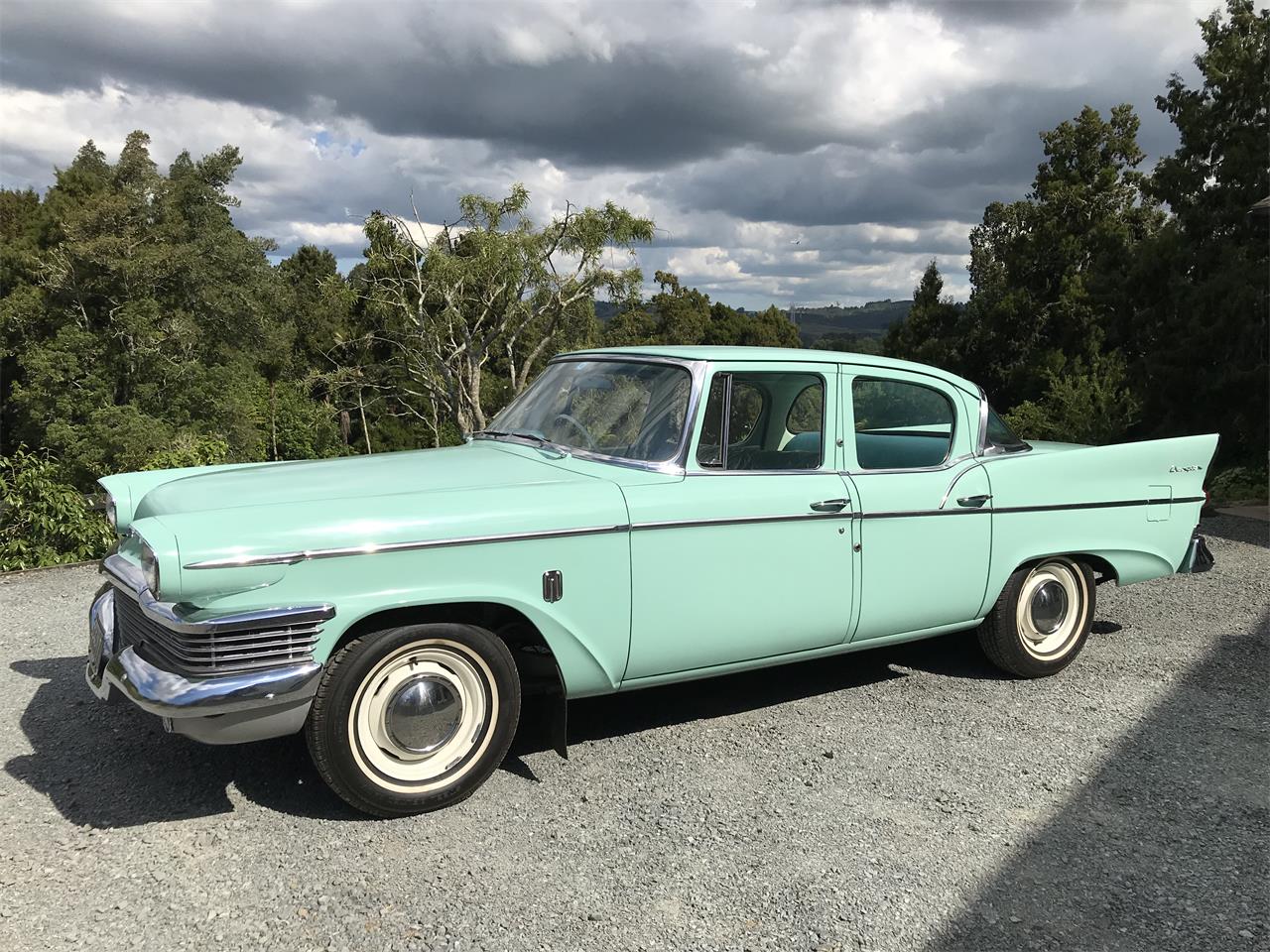 1958 is
a year in which Studebaker is just trying to get by until the planned
Lark can be introduced in the fall. Interesting, is the amount of
money Studebaker would speed to produce the Packard Hawk and the
Sedan Hardtops, considering they were aware these models most likely
would not be needed in a Lark based future. However, this was not
the big news for 58, it was the pod based duel headlights and large
tail-fins. The add-on pods looked like a poorly though-out,
nickel-and-dime design, Studebaker would most likely have been better
off without. We probably need to cut Duncan McRae some slack, as for
sure he had little tooling dollars to work with. The fins, fared a
little better and looked the best on the longer Presidents. The
product line is reduced from 23 models to 17, which included the
release two new models. The result would be a significant reduction
of the number of Scotsman and Champion models. The Scotsman would
field 2 & 4 Door Sedans and a 2 Door Wagon. The Champion would
be available (Domestically) in only 2 Door and 4 Door Sedans. The
Champion line would be the models least effected by pods and fins. The Scotsman
was designed with 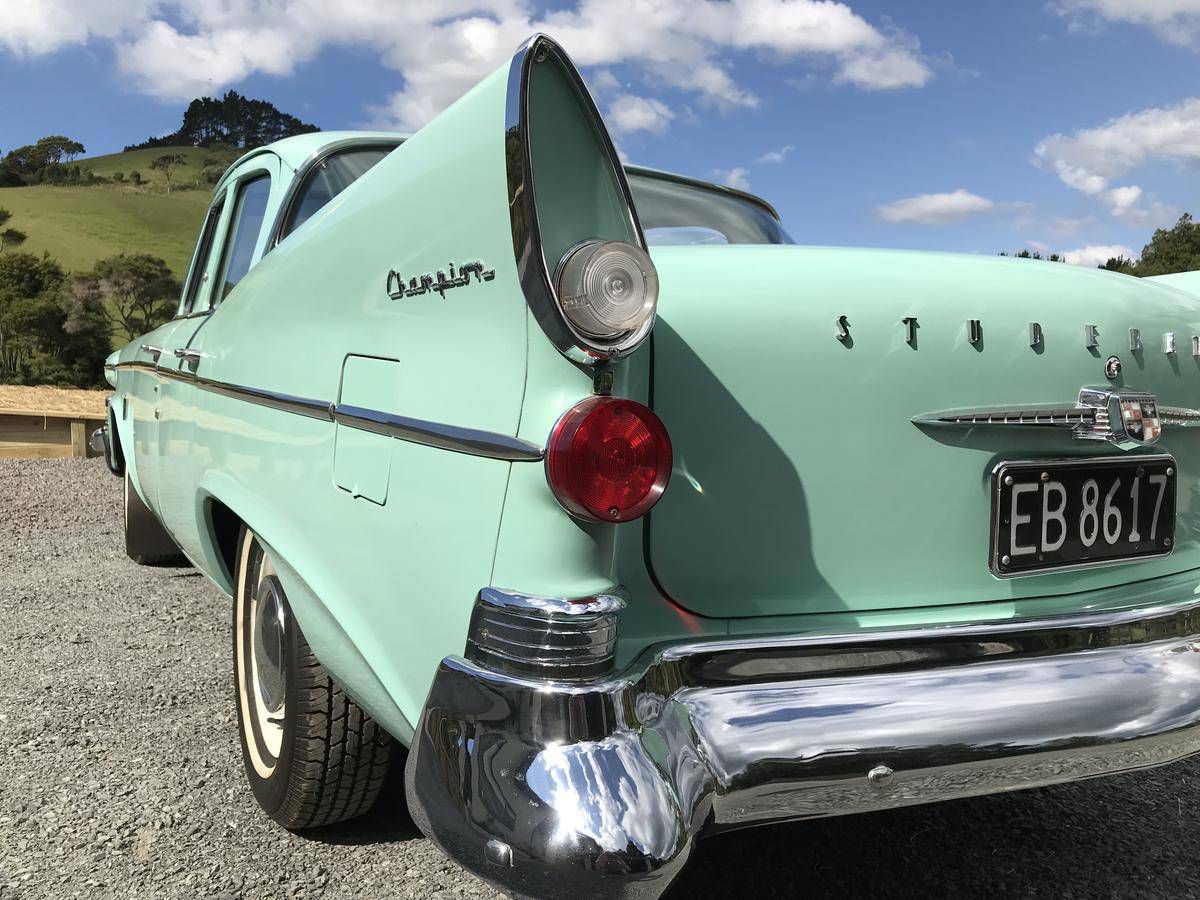 neither. Exterior Scotsman changes are in the
center grille where the pattern is now square instead of rectangular
and the taillights which are now round instead of being oval. It
does however get the grille based vent system (gone in the entire
sedan and wagon line are the front fender vents seen since 1941), new
“Studebaker” script on the left rear fender, and the lowered roof
on the sedans. The Champion gets the pods, but 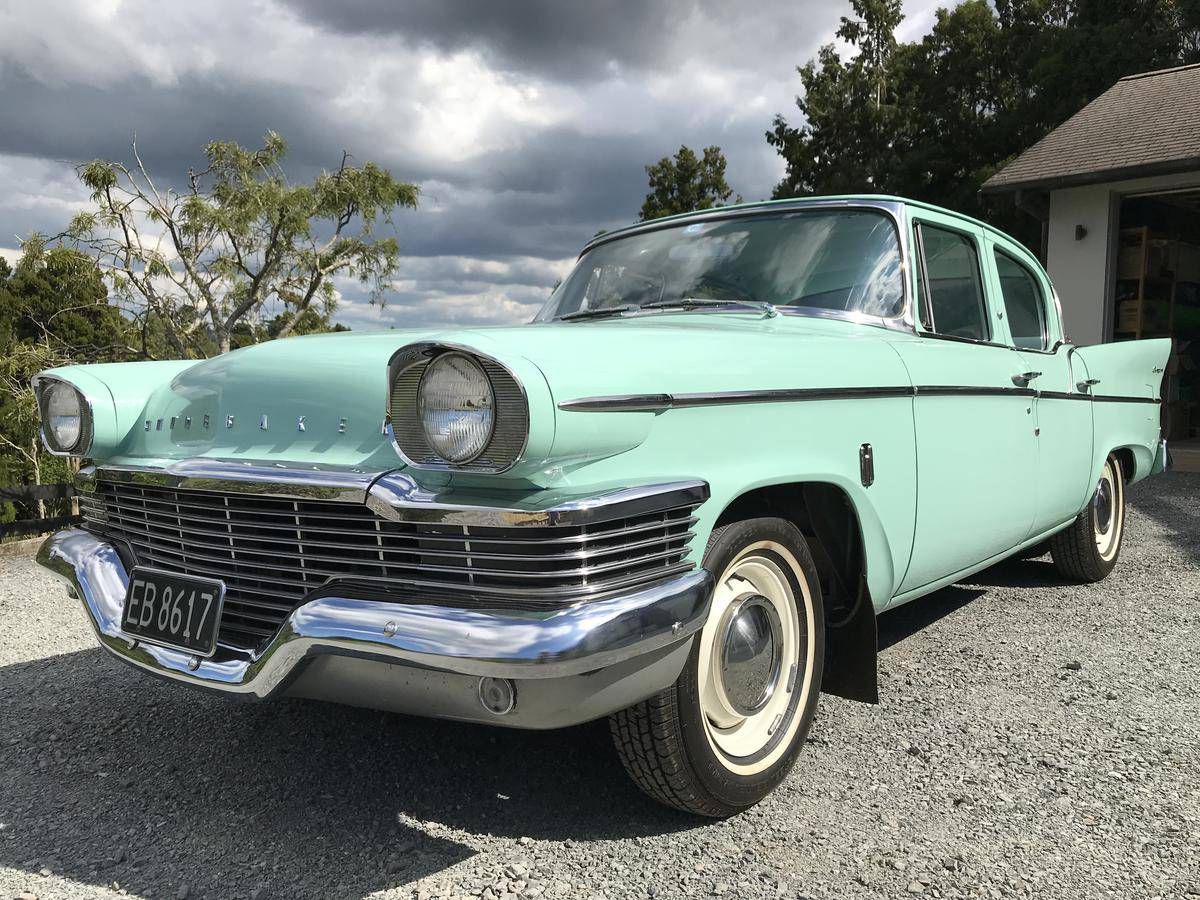 only a single
headlight (duel headlights are optional) and the fins. It also gets
round taillights and a refined grille. The hood ornament and and
crest are eliminated and “Studebaker” is now displayed near the
bottom of the hood. There are no interior changes to the Scotsman. Champion changes include an enlarged speedometer 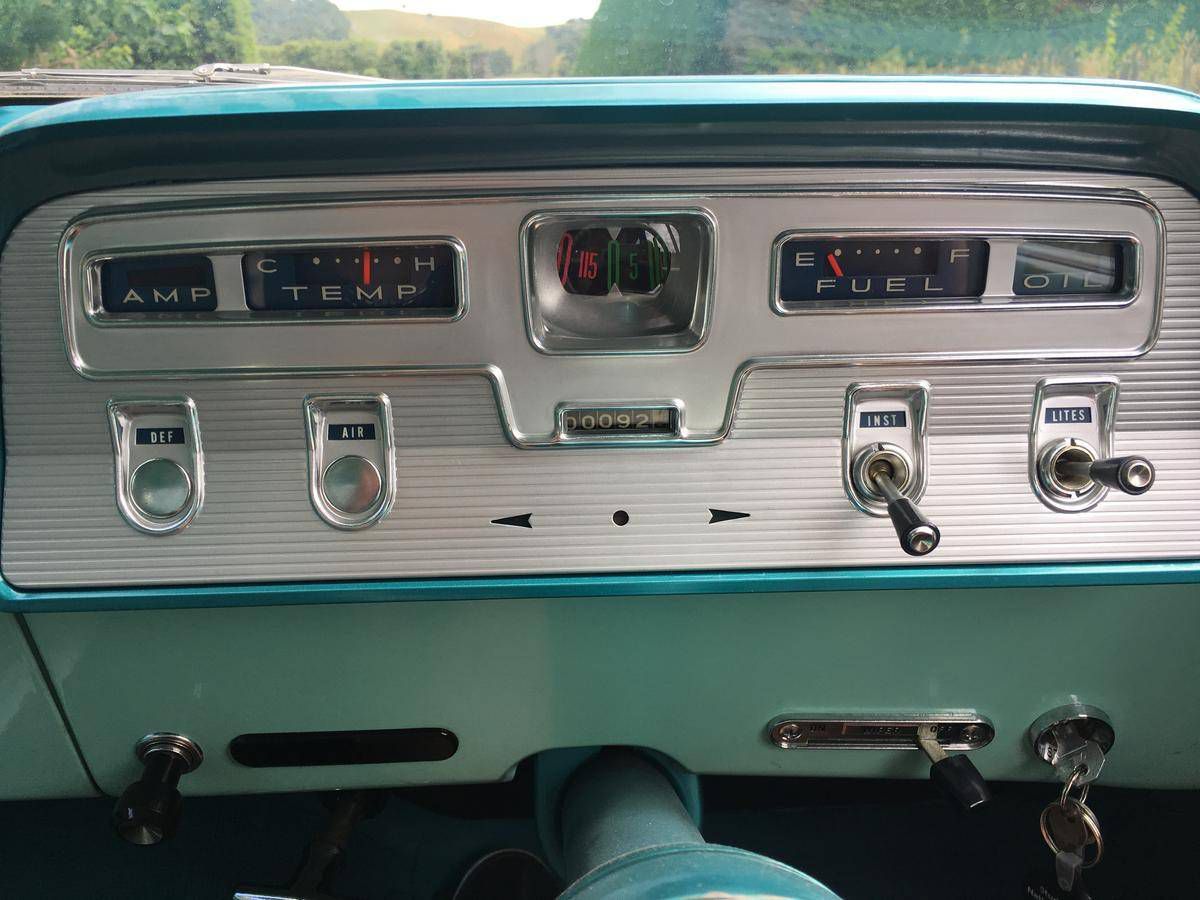 housing to hold
all the gauges and several of the toggle switches. The ignition
keyway is lighted and smaller flush-level door sill molding are
added. Many new fabrics, colors and prints are available in cloth
and vinyl or all vinyl.
Mechanical
changes are asymmetric rear springs (longer to the rear), a new
one-piece drive shaft, and the 14 inch tires found on the Commanders
and President are made optional on Champion's.
Restoration
Information: The engine block was painted Silver-grey. The air cleaner, generator, oil filler cap, and starter were Black. Pan & fan, either Silver-grey or Black. Fuel pump, wiper motor,
and carburetor were natural metal. Studebakers came in a wide array of interior fabrics. The best source of information is the 1958 Color and Fabric Selector (PD 8003). The fabric code can be found on the production order for each car. The materials had names like Tabby, Jacquard, Thumbprint, Sawtooth, Abstract, Tweed, and Starburst.
|
Exterior Solid Colors for 1958 Scotsman Sedans & Wagons |
|
Color |
Code |
|
Midnight Black |
P5810 |
|
Parchment White |
|
|
Loch Blue |
|
|
Glen Green 1 |
|
|
Glasgow Grey 1 |
|
|
Surf Green 2 |
|
|
Cliff Gray 2 |
|
|
Parade Red 2 |
|
|
Mile-A-Thon Yellow 3 |
|
|
1 Colors phased out in May 1958 2 Made available on Scotsman May 15th, 1958
3 Offered for a short time during the Mile-A-Thon Contest |
|
Exterior Solid Colors for 1958 Champion Sedans & Wagons |
|
Color |
Code |
|
Midnight Black |
P5810 |
|
Waterfall Blue
|
|
|
Mountain Blue Metallic |
|
|
Park Green Metallic |
|
|
Surf Green |
|
|
Jewel Beige |
|
|
Cliff Gray |
|
|
Buff Grey Metallic |
|
|
Canyon Copper Metallic |
|
|
|
|
|
|
|
|
Parade Red |
|
|
|
|
|
Exterior Two-Tone Colors for 1958 Champion Sedans & Wagons |
|
Base Color |
Accent Color |
Code |
Code Reverse Color |
| Park Green Metallic |
Surf Green |
P5826 |
P5827 |
| Mountain Blue Metallic |
Waterfall Blue |
P5828 |
|
| Buff Grey Metallic |
Cliff Gray |
P5830 |
|
| Canyon Copper Metallic |
Jewel Beige |
P5832 |
|
| Midnight Black |
Parchment White |
P5834 |
|
|
Canyon Copper Metallic |
|
P5836 |
|
| White Gold Metallic |
|
|
|
| Park Green Metallic |
|
|
P5841 |
| Surf Green |
|
|
N/A |
|
|
|
|
|
|
|
|
|
|
|
|
|
|
|
|
|
|
|
|
|
|
|
|
|
|
Shadowtone Red Metallic |
|
|
|
|
|
|
|
|
|
|
Midnight Black |
|
|
|
Parade Red |
|
|
|
|
Model |
No.
Doors |
Passengers |
Original
Price |
TW
Original Price |
No.
Produced |
|
Scotsman
4Dr Sedan (W1) |
4 |
6 |
|
|
5,538 |
|
Scotsman
2Dr Sedan (F1) |
2 |
6 |
$1,795.00 |
$1,795.00 |
7,654 |
|
Scotsman
2Dr Wagon (D1) |
2 |
6 |
$2,055.00 |
$2,055.00 |
7,680 |
|
Champion
2Dr Sedan (F4) |
2 |
6 |
$2,185.00 |
$2,189.00 |
1,455 |
|
Champion
4Dr Sedan (W4) |
4 |
6 |
$2,353.00 |
$2,253.00 |
5,178 |
|
Champiom
4DR Wagon (P4) |
4 |
6 |
? |
? |
122 |
|
Champion
Sedan Hardtop (J4) |
2 |
6 |
? |
? |
1202 |
|
Total |
27,637 |
2 Export Yellow background information comes from (Studebaker The Complete Story)
|
Starting
Serial Numbers 58G 1,405,401 South Bend ─
772,301 Canada
Starting
Engine Numbers 58G 1,228,401 South Bend ─
C-74,701 Canada
Information
in this chart comes from (CCD) unless otherwise noted. The price and production information from CCD exactly matched TW August 1991
|
|
|
|
|
|
|
|
 |
|